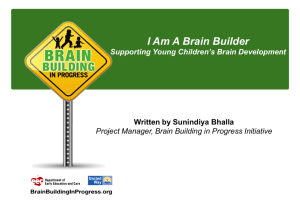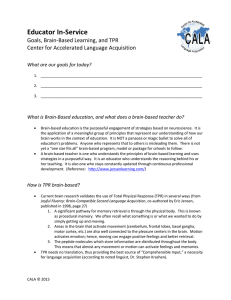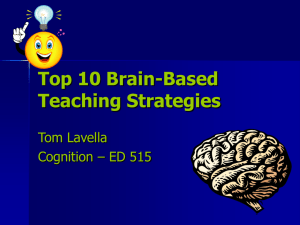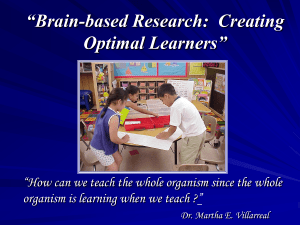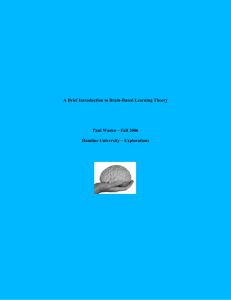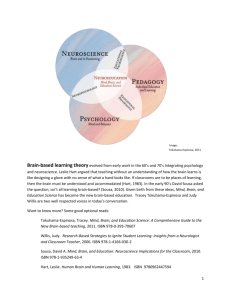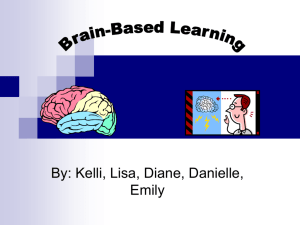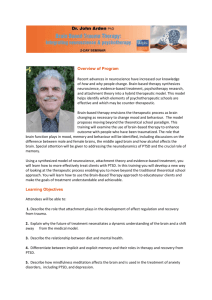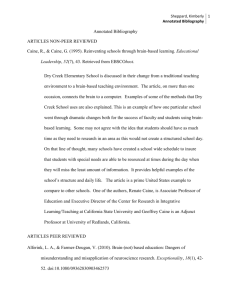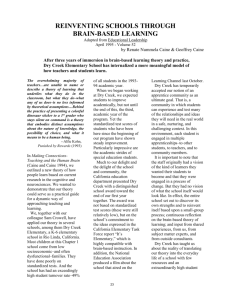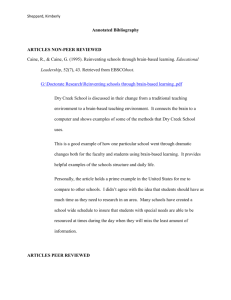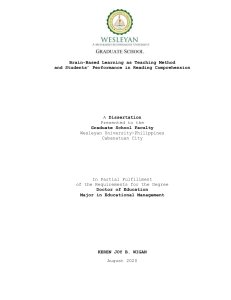Brain-Based Learning Presentation
advertisement
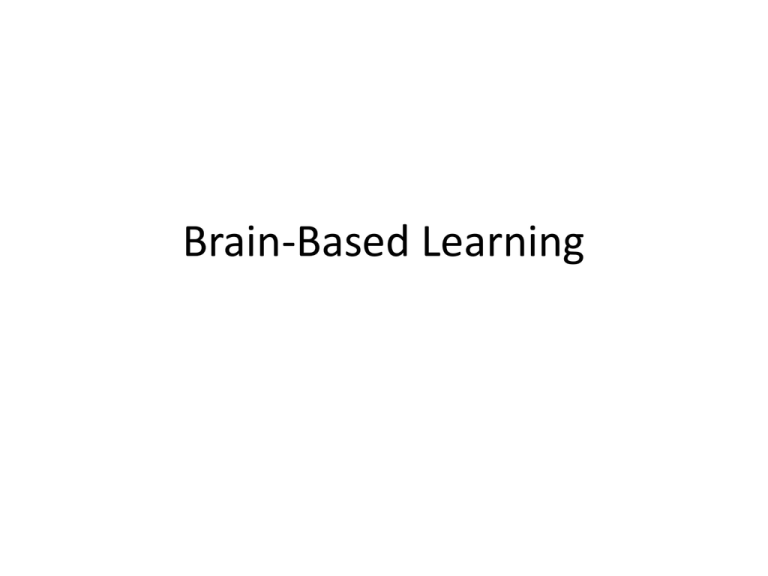
Brain-Based Learning Multiple Learners • Multiple intelligences – Could do another workshop on that controversy entirely – Sometimes tied to brain-based learning, but not always So What is it? • Seems to be whatever • There are some common themes Origins • Hart (1983). Human Brain and Human Learning • Caine and Caine (1991) Making Connections: Teaching and the Human Brain Common Themes • • • • Glucose levels Synaptogenesis Safety (importance of emotions) The key is establishing patterns – The brain wants to make sense of patterns • Everyone is different Edutopia’s Six Tips • • • • • • Create a “safe climate” for learning Encourage a growth mind-set Emphasize feedback Get bodies and brains in gear Start early Embrace the power of novelty Brain-Based Learning Practices • Just about everything – From candy to color • Focused on K-12, though we do hear about it in higher ed. • Team building activities; rituals especially the physical • High energy, multimedia rich classrooms • Students focus on “real” problems • Student customization and focus of curriculum So what’s the problem? • Mix of practical, theoretical, etc. Focus on Feelings • Concern that students are coddled • Need to for positive emotions outweighs rigor • Some “Brain-based” learners do suggest a balance (e.g. “Relaxed alertness”) Example • “The Instructor, rather than evaluating for correctness, provides feedback (an important distinction) on content and form, and answer questions like ‘How does this work make me feel?’ rather than ‘Does this work say what I want it to say?” Keto, A. (2005). Integrating Brain-Based Learning in the College Composition Classroom Focus on multimedia • Clark’s grocery truck • Hard to separate medium and method • Time taken to develop Clark, R. (1994). Media will never influence learning. Educational Technology Research and Development 42(2), 21-29. Retrieved from http://www.jstor.org/stable/30218684 Cognitive load • The task of negotiating and exploring a domain is expensive – In other words, students focus more on the logistics than the content • Experience does not give concepts meaning, if anything ‘concepts give experience meaning’” Financial motive • For-profit companies like to use “Brain-based” • “There are no formal guidelines to which researchers, curriculum publishers, or private educational consultants must adhere when they make claims about brain-based educational strategies.” – Judy Willis M.D. Brain chemistry unknowns • Correlation between synapse density and glucose level established – But that doesn’t imply a casual inference Synaptogenesis • Brain has been shown to be flexible – Not necessarily a small window Goswami, U. (2006). Neuroscience and education: from research to practice?.Nature Reviews Neuroscience, 7(5), 406-413. Neural density • Exact relationship between neural density is not understood • Neural density may not tie to particular learning outcomes • We know which parts of the brain are active during learning but not the interaction – Still true but we have more precise images Bruer (1997). Education and the Brain: A Bridge Too Far. Educational Researcher 26(8), 4-16 Which leads us to the problem… • “People have been sold a bill of goods that there is enough here to make curricular decisions.” – Kathryn Hirsh-Pasek, Temple University http://www.thedailybeast.com/newsweek/2007/10/13/the-case-for-chutes-andladders.html In search of… Results of neuroscience Elvis Generalized practice • “…the current fashion for brain-based learning, in which value-laden claims about learning are grounded in neurophysiology.” Davis, A. (2004). The credentials of brain‐based learning. Journal of Philosophy of Education, 38(1), 21-36. Example • Stress shown to affect later learning development • So what does that mean for the classroom? Another Example Is there anything there? • Some of the things we encourage are promoted by “brain-based” learning Active learning • Students doing more than rote learning when possible Real Problems • “Engaged” learning Encouraging students • “Threat” vs. “Challenge” Basic needs • Who is going to argue against eating right? Conclusion • Research is interesting but there is a gap between conclusions and what becomes practices • Those which are the safest practices have been suggested without brain ties What’s the solution? • Tommerdahl, J. (2010). A model for bridging the gap between neuroscience and education. Oxford Review of Education, 36(1), 97-109. Questions or comments?
